Canine Coat Colour Genetics & The Miniature Schnauzer
Coat colour In The Miniature Schnauzer
Knowing the loci and the alleles that control colour in dogs is only the first step. In addition to the relationships between alleles at each locus, one must also factor in the the relationship of loci in relation to each other across the chromosomal pairs.
With dominance, one allele of a gene masks the expression of another allele of the same gene.
Epistasis occurs when a mutation in one gene masks or disables the expression of genes at a different locus a -- genetic "trump card". In some cases, epistasis occurs when one copy of the masking gene is present, in others two copies are required.
Like all dogs, schnauzer colours are comprised of the two base "black" and "tan" pigment types.
The Agouti series determines where and when black and tan pigment is deposited. The only alleles schnauzers carry at this locus are the allele I've designated "ap" (pepper) and "at" (tanpoint).

Heterozygous dogs often exhibit intermediate expression, which may result in a delay in the switch from black to tan, and longer black tips on banded hairs. The effect can vary from very subtle to so strong that the dog shows only a few banded hairs in a coat of show length.
The Intense locus dilutes tan pigment only. All schnauzers are homozygous for this gene. Why do we know this? If heterozygotes existed in the breed, puppies with normal reddish-tan pigment would occur, with adult coat colour similar to wild boar dachsunds.
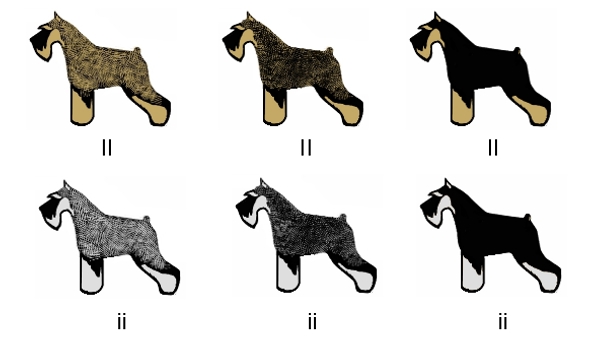
The blacK - K locus is epistatic to the Agouti locus. The gene for dominant black competes with the pigment switching action of agouti, effectively "turning it off". The effect is the same whether one or two copies of the gene are present at K.
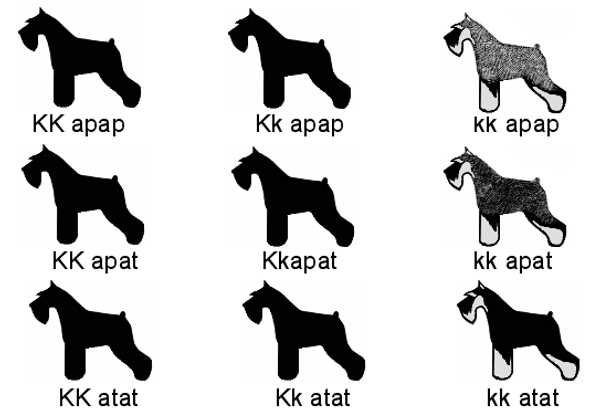
Greying genes cause the pigment production in the follicle to gradually shut down. Stripping of the hair restarts the pigmentation process anew - this is why the scissored and clippered areas of schnauzers will fade out with age, while the stripped topcoat retains its intensity. Dogs with two copies of this dominant gene seem to express more strongly than heterozygous dogs.
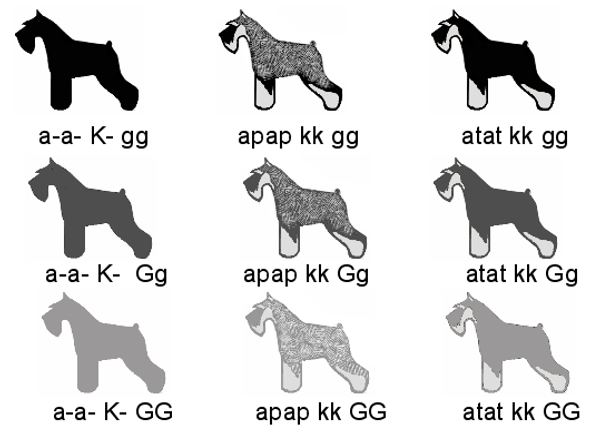
E - Extension is epistatic to agouti and dominant black. Schnauzers who have one or two copies of the normal version of this gene are unaffected. Dogs with two copies of recessive "e" are incapable of producing black pigment in the hair (though nose and pads are unaffected.) Because all schnauzers are homozygous for the tan dilution factor, ee schnauzers are white to cream in colour. It would seem logical that the presence of GG or Gg greying may clear tan pigment from "ee" white dogs even further.
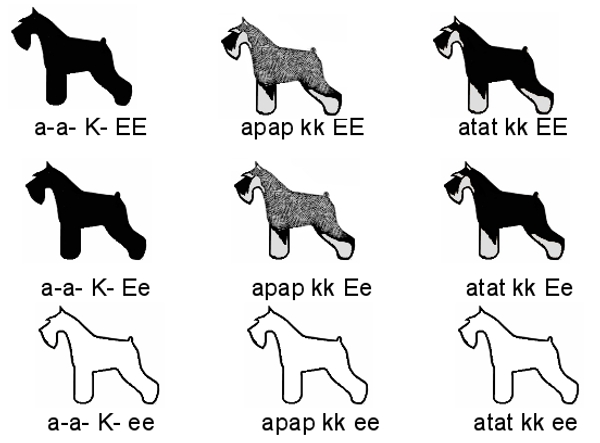
Those Other Colours...
A number of miniature schnauzers are registered each year as livers or chocolate. This is due to the presence of recessive brown dilution, and converts all forms of black to brown in the homozygous form.
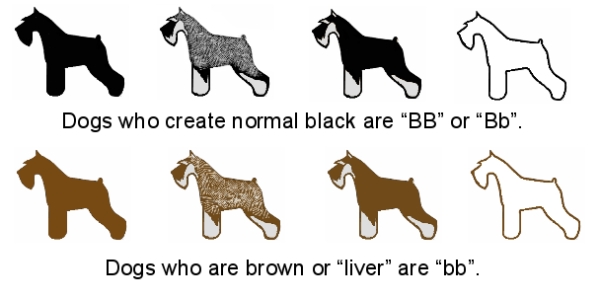
In addition, the AKC registers a particolour patterned miniature schnauzers. A particolour schnauzer occurs in the presence of piebald spotting may be of any colour found in the gene pool.

A Word On "Colour Crossing"
A great deal of confusion and misunderstanding has arisen in our breed in recent years, as the popularity of blacks and black/silvers has led to increasing numbers of litters born of parents of different colour bases.
Some believe that the practice of "colour crossing" has led to greying of the black varieties on one hand. and a deterioration of salt & pepper banding clarity on the other.
As we have seen, all black schnauzers also carry two alleles at the agouti series. It isn't possible to "introduce" salt&pepper or black/silver patterning into blacks through colour crossing, as the genes for one or both of these patterns are already there.
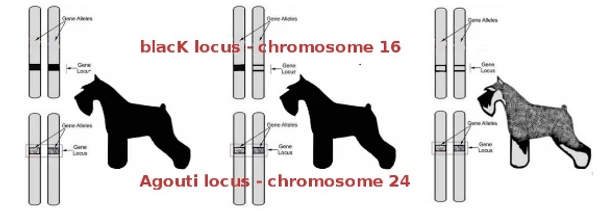
In the case of dark coated heterozygote salt&peppers, it is the combined action of both genes acting upon pigment production that produces longer black tips on the hairs. Pairing these alleles does not contaminate either. While some breeders may dislike this effect, it is not evidence of a genetic flaw - it is the result of intermediate expression. Some of these dark dogs may owe their colour intensity to a lack of progressive greying - a gene series inherited independent of agouti interactions.
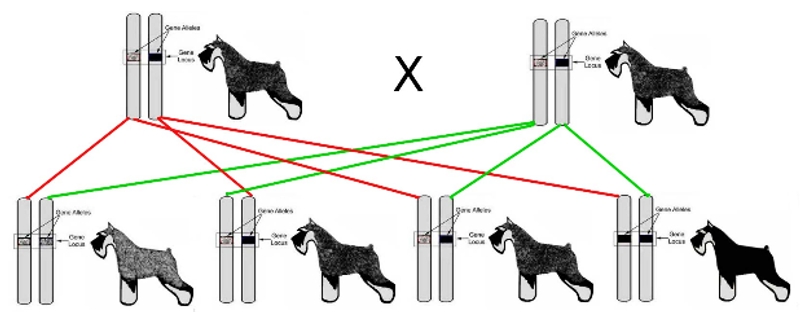
What is true is that it is easier for breeders to select for traits like colour intensity and retention when they limit the puppies they produce to a single phenotype. If all of one's puppies are black, it is easier to choose the ones who retain their colour.
But it is equally true that if all of one's black stock is GG greying, one can breed homozygous KK blacks together for an eternity and colour retention will never improve.
To improve traits such as banding clarity or colour retention in blacks, one must focus on what is going on at the greying locus, for this is most likely the prime culprit in both. GG - greying = clearer bands, paler greys, and brighter silvers. "gg" (no greying) = blacks that retain pigment intensity, and salt & peppers with black undercoats and dark leg overlays.
Of course, genes are only the beginning and these primary loci only part of the puzzle. In addition to other genetic modifiers, secondary traits such as hair texture and quality, diet, temperature, stress, and exposure to sunlight may all play a role in the expression and modification of pigment.
However, understanding the basics of colour genetics, and the ways in which the alleles and gene loci interact is necessary if one is to know the difference between an undesirable colour that deserves to be faulted, and a phenotype that is the normal and expected result of heterozygosity.
Sources
Special thanks to Sheila M. Schmutz Ph.D., College of Agriculture and Bioresources, University of Saskatchewan - Genetics of Coat Color and Type in Dogs
For information on dna testing for coat colour, visit HealthGene (Canada) or VetGen (USA).